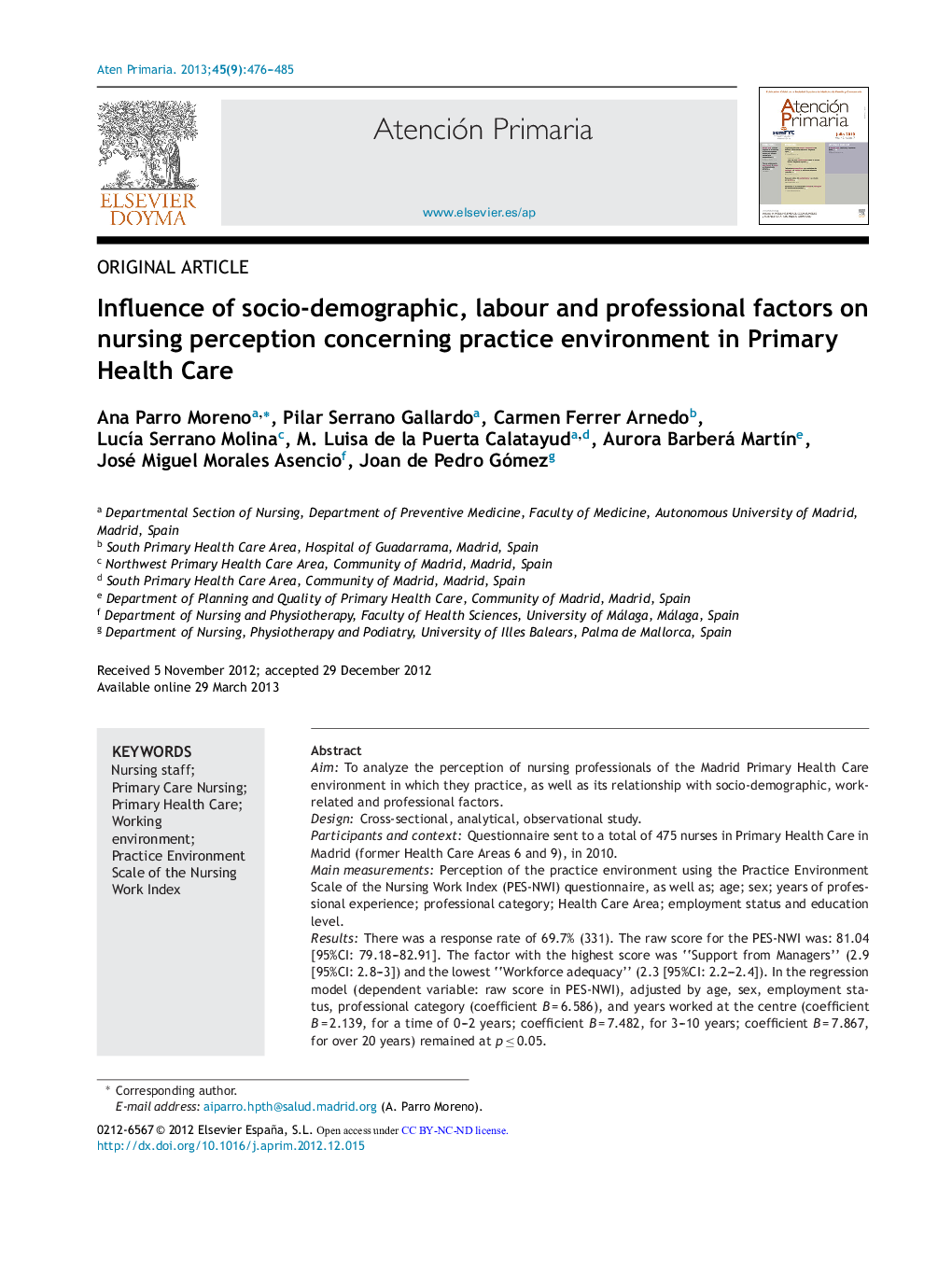| کد مقاله | کد نشریه | سال انتشار | مقاله انگلیسی | نسخه تمام متن |
|---|---|---|---|---|
| 3457922 | 1230940 | 2013 | 10 صفحه PDF | دانلود رایگان |

AimTo analyze the perception of nursing professionals of the Madrid Primary Health Care environment in which they practice, as well as its relationship with socio-demographic, work-related and professional factors.DesignCross-sectional, analytical, observational study.Participants and contextQuestionnaire sent to a total of 475 nurses in Primary Health Care in Madrid (former Health Care Areas 6 and 9), in 2010.Main measurementsPerception of the practice environment using the Practice Environment Scale of the Nursing Work Index (PES-NWI) questionnaire, as well as; age; sex; years of professional experience; professional category; Health Care Area; employment status and education level.ResultsThere was a response rate of 69.7% (331). The raw score for the PES-NWI was: 81.04 [95%CI: 79.18–82.91]. The factor with the highest score was “Support from Managers” (2.9 [95%CI: 2.8–3]) and the lowest “Workforce adequacy” (2.3 [95%CI: 2.2–2.4]). In the regression model (dependent variable: raw score in PES-NWI), adjusted by age, sex, employment status, professional category (coefficient B = 6.586), and years worked at the centre (coefficient B = 2.139, for a time of 0–2 years; coefficient B = 7.482, for 3–10 years; coefficient B = 7.867, for over 20 years) remained at p ≤ 0.05.ConclusionsThe support provided by nurse managers is the most highly valued factor in this practice environment, while workforce adequacy is perceived as the lowest. Nurses in posts of responsibility and those possessing a higher degree of training perceive their practice environment more favourably. Knowledge of the factors in the practice environment is a key element for health care organizations to optimize provision of care and to improve health care results.
ResumenObjetivoAnalizar la percepción de los profesionales enfermeros de atención primaria de Madrid sobre el entorno en el que realizan su práctica, también relacionada con los factores sociodemográficos, laborales y profesionales.DiseñoEstudio observacional analítico transversal.Participantes y contexto475 enfermeros de Atención Primaria de Madrid (áreas 6 y 9, en 2010).Mediciones principalesPercepción del entorno de la práctica, a través del cuestionario Practice Environment Scale of the Nursing Work Index (PES-NWI); edad; sexo; años de experiencia profesional; categoría; área de salud; contratación y nivel académico.ResultadosSe estudiaron 331 sujetos (tasa de respuesta: 69,7%). La puntuación bruta para el PES-NWI fue: 81,04 [IC 95%: 79,18-82,91]. El factor mejor valorado fue «Apoyo de los gestores» (2,9 [IC 95%: 2,8-3]) y el peor, «Adecuación de la plantilla» (2,3 [IC 95%: 2,2-2,4]). En el modelo de regresión (variable dependiente: puntuación bruta del PES-NWI), ajustado por edad, sexo, situación laboral, permanecieron con una p ≤ 0,05, la categoría profesional (coeficiente B = 6,586) y los años de ejercicio profesional en el centro (coeficiente B = 2,139, para tiempo de 0 a 2 años; coeficiente B = 7,482, para tiempo de 3-10 años; coeficiente B = 7,867, para tiempo de más de 20 años).ConclusionesLas enfermeras con cargo de responsabilidad y aquellas que tienen mayor formación tienen una mejor percepción de su entorno de práctica. Conocer los factores del entorno de la práctica es un elemento clave para la organización sanitaria con el fin de optimizar la provisión de cuidados, y mejorar los resultados en salud.
Journal: Atención Primaria - Volume 45, Issue 9, November 2013, Pages 476–485